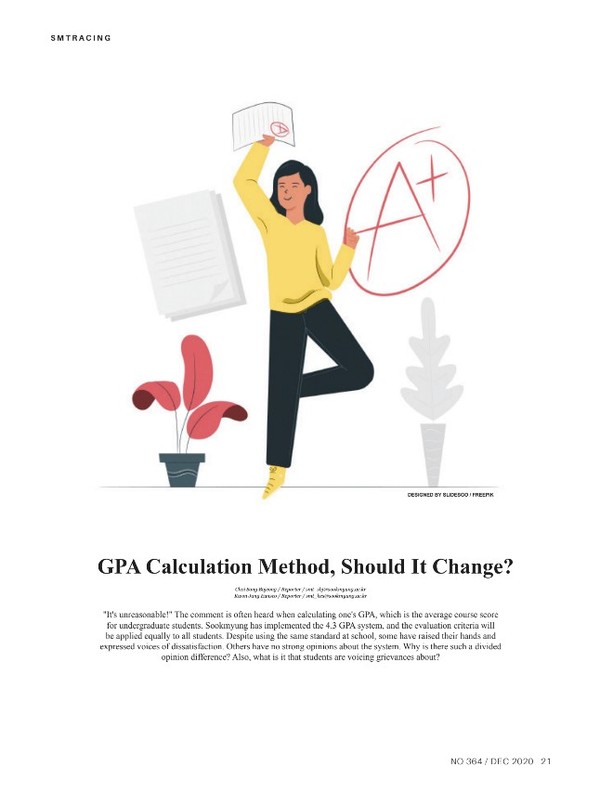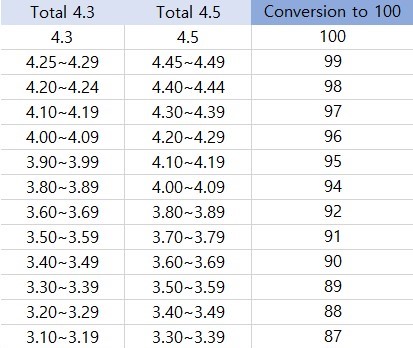
"It's unreasonable!" The comment is often heard when calculating one's GPA, which is the average course score for undergraduate students. Sookmyung has implemented the 4.3 GPA system, and the evaluation criteria will be applied equally to all students. Despite using the same standard at school, some have raised their hands and expressed voices of dissatisfaction. Others have no strong opinions about the system. Why is there such a divided opinion difference? Also, what is it that students are voicing grievances about?


Students' lives are intertwined with GPA scores
Currently, the GPA calculation system continues to be a controversial issue under constant discussion at Sookmyung Women's University. GPA stands for Grade Point Average, which usually represents the average score earned in courses over four years at university. Depending on the university, the calculation method, however, differs. Scores of 4.0, 4.3 or 4.5 are all possible perfect scores. Most Korean universities utilize the 4.5 or some form of a 4.3 system. Sookmyung has chosen to implement the 4.3 credit rating system, which began in the 1980s. According to the Sookmyung Office of Academic Affairs, they said "Sookmyung Womens' University adopted the 4.3 GPA system in the '80s when the democratic movement led society into confusion and sanctions were imposed on the education sector. At that time, the graduation quota system was implemented in order to normalize university education. The 4.3 GPA system was aimed at minimizing the number of dropouts. It can be found more about it in Sookmyung’s history for 100 years." In other words, Sookmyung changed its GPA system to respond to changes in society and imposed sanctions in the education sector. The GPA scores calculated in this 4.3 system manner have a lot of influence on Sookmyungians including their future employment, receiving of scholarships, and participation in overseas study exchange. Details on why GPA scores are important to college students can be found in the FEATURE of The Sookmyung Times No. 334, "Students' Lives are wrapped around GPA Scores."
In addition to the above mentioned preceding factors, the GPA calculation method also influences students preparing for a college transfer such as to Law School (LEET) or the College of Pharmacy (PEET). LEET stands for Legal Education Eligibility Test, which is conducted with the aim of selecting qualified applicants during admissions. PEET stands for Pharmacy Education Eligibility Test. Students who have taken the introductory qualification exam and have acceptable levels of qualifications required by the university hosting the College of Pharmacy may transfer in their third year to pharmacy. Many students who are preparing for entering them need high GPA scores because evaluators look at their GPA percentile during admissions. One student preparing for one of those tests at Sookmyung said, "I'm preparing to enter a College of Pharmacy, so my GPA score percentile is very important. I need to get over 95 points for it to be considered a high score." Then, one's GPA percentile score plays a key role in entering College of Pharmacy and Law schools; in other words, it greatly affects the future of college students. To sum up, Sookmyung Women’s University calculates students' perfect GPA score at 4.3, so when it is converted to 4.5, it becomes more advantageous. However, when converted to a percentile score, it places the students at a disadvantage.

The ground between satisfaction and dissatisfaction
As previously discussed, Sookmyungians need higher GPA scores for their future. Explanation on how each university calculates its students' GPA score varies. In Korea, all cyber universities, universities for industry, and technical colleges use a 4.5-point system. There are few schools like Sookmyung that are using a 4.3-point system. Sogang University, Seoul National University, Yonsei University, and Ewha Womans University also use a 4.3-point system. Many Sookmyungians who are preparing to get a job have requested the Sookmyung Office of Academic Affairs to interview them in order to learn more about whether the current GPA calculation method is negatively influencing their opportunities in the job market. They replied to this "Do you think the school's GPA score calculation method is helping or harming students at Sookmyung Women's University when they prepare for employment?" with "That is not something that can be answered simply as different companies have different assessment conditions." In other words, Sookmyung cannot provide a direct answer to the correlation between Sookmyung Women's University student employment and the GPA calculation method. One anonymous Sookmyungian who is about to graduate agreed to participate in the interview. She said, "I've never heard of any job opportunity disadvantage in getting a job simply because of the school's GPA calculation method. However, I recognize that low scores that are granted to students can cause harm." Then, the GPA calculating method may not actually be an advantage or disadvantage in terms of employment, yet there is another problem.
There have been constant complaints from Sookmyungians who are preparing to enter a College of Pharmacy or Law school. When a student's grade is converted into a percentile, the student is clearly at a disadvantage compared to the number of students with similar percentages from other universities. When SMT asked students preparing for those schools, "Do you think the current GPA calculation standard at our school causes unfair competition from other universities' students?" 114 out of the 117 respondents (97.4%) said "It was unfair".1) One anonymous Sookmyungian who participated in a survey said, "I am preparing for the Law school, but it's not easy. There is a lot of gap between Sookmyung's GPA and other university students' GPA. I have an acquaintance who attended Chung-ang University, and I remember that her grade ended up being one point higher than mine. That one point is big on the Law school." As she stresses, when the Sookmyung GPA is converted into a percentile, the difference in scores stands out clearly and it places Sookmyungians at a clear disadvantage. The same situation occurs among Sookmyungians who are preparing to enter a College of Pharmacy. Another anonymous Sookmyungian preparing for this college said, "Even though I have the same grade as students from other schools who are preparing for the transfer, I feel I am at a disadvantage because the GPA percentage was set low." In other words, the 4.3 GPA system is working against students preparing for Law school or College of Pharmacy.

From a dissatisfied point of view
It is clear that the current method of calculating students' GPA is affecting some students negatively, especially those preparing for particular tests, so these students are seeking action at school to resolve the disadvantage. For instance, the 38th Student Council 'Daheum' from the Division of Law demanded an investigation by the school into GPA conversion criteria. While efforts like this continue, SMT asked about the current situation regarding the percentile conversion problem being managed by the Office of Academic Affairs. One representative replied with "We are currently investigating possible changes to percentile conversion criteria based on the needs of Sookmyungians. We are looking at it from various channels of communication and investigative measures. However, this investigation is not on the purpose of contributing to Sookmyungians' test advantage." The reply shows that the school is taking the concern seriously and looking at countermeasures to prevent any disadvantage.
Under this circumstance, SMT examined students' opinions about changes of the current calculation method. According to the survey, 138 of 148 respondents (93.2%) favor changes to the current system while 10 of 148 respondents (8.8%) do not want changes.2) The difference between the two extremes is more than 11 times. According to survey participants, positive results will be seen if the current GPA system is changed. One anonymous participant in the survey said "If the current GPA system is changed, students can overcome the competitive weakness they experienced in relation to their grades and this would ultimately lead to an improved school image because more students would be successful on the tests. Above all, changes to the method of calculating the GPA would contribute to a better study environment by providing more stability to students who suffer from anxiety knowing they are at a disadvantage." While students' voices for improvement have been unceasing, a representative from the Office of Academic Affairs said in an interview with SMT, "The school is considering possible directions for improvement including changing the method of percentile conversion. We are not yet ready to announce our findings or our official position as it is still conducting an investigation of other universities and analyzing the results of our university's monthly assessment." Through this, the school appears to be taking the matter seriously and is actively pursuing a resolution. Therefore, students can expect to know about the situation in the near future.


A different past, present, and future
Sookmyung's method of calculating students' GPA was implemented for a specific purpose in the 1980s, but some students are complaining about it now. Sookmyung is looking into the situation and discussing solutions. The problem is real and should be considered carefully as students’ future may depend on how their GPA is calculated. In other words, there is a need for improvement to address problems. Once solutions are presented and implemented, both students who are directly affected by the GPA calculation method and Sookmyung can expect positive change in the right direction.
1) The total number of students enrolled is 12,094, with a survey participation rate of about 0.9%
2) The total number of students enrolled is 12,094, with a survey participation rate of about 1.2%
Choi Song Bojeong / Reporter
smt_sbj@sookmyung.ac.kr
Kwon Jung Eunseo / Reporter
smt_kes@sookmyung.ac.kr


